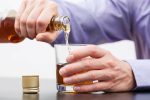The changes to your heart’s shape cause long-term damage, leading to heart failure and severe problems. Abstaining from alcohol may help some people recover, but others will need medication or even surgery. Considering all the works conducted to date, it is clear that new studies on the natural history of ACM are needed, including patients treated with contemporary heart failure therapies. In light of the available data, new studies will help to clarify the current prognosis of ACM compared to DCM and to determine prognostic factors in ACM that might differ from known prognostic factors in DCM. The first study, which specifically focused on the amount of alcohol necessary to cause ACM, was conducted by Koide et al20 in 1975. The authors examined the prevalence of cardiomegaly by means of chest x-rays and related it to alcohol consumption among a consecutive series of Japanese males of working age.
Abnormal heart sounds, murmurs, ECG abnormalities, and enlarged heart on chest x-ray may lead to the diagnosis. Many medications can help in cases of alcohol-induced cardiomyopathy, treating the symptoms that happen because of this condition. Medications typically include beta-blockers (for heart rhythm and blood pressure issues) and diuretics (to help your body get rid of excess fluid and swelling). Alcohol has toxic effects, but your body can limit the damage and break alcohol down into non-toxic forms if you don’t drink too much too quickly. However, consistent heavy drinking strains those protective processes — especially in your liver — making them less effective.
They found that 2 of the 6 individuals (33%) whose alcohol consumption exceeded 125 mL/d had cardiomegaly. In contrast, an enlarged heart was found in only 1 of 25 subjects with moderate consumption (4%), in 6 of 105 very mild consumers (5.7%), and in 4.5% of non-drinking individuals. In their autopsies, he described finding dilated cavities of the heart and fatty degeneration of the ventricular walls14. Most common age population for ACM is males from age with significant history of alcohol use for more than 10 years. Females constitute roughly 14 % of cases of alcohol induced cardiomyopathy however lifetime exposure required for women to develop alcohol induced cardiomyopathy is less compared to men. Dilated cardiomyopathy secondary to alcohol use does not have a pre-defined Alcoholics Anonymous exposure time.
The only way to cure alcohol-induced cardiomyopathy is with a heart transplant. However, this is usually not an option because there are so few hearts available from organ donors. For that reason, transplant programs have very strict list requirements to qualify for a transplant and abstaining from alcohol is almost always https://www.montenuovoapp.it/2022/03/23/10-celebrity-alcoholics-who-drank-themselves-to-4/ on those lists.

This inability occurs despite adverse effects on the person’s health, occupation, or relationships. In patients exhibiting chronic alcohol use, other causes of dilated cardiomyopathy need workup. Investigative work up such as mean corpuscular volume (MCV), gamma-glutamyl-transpeptidase (GGT), elevated transaminases (AST, ALT) and elevated INR usually are seen in liver injury can be helpful as supportive evidence of alcohol use.1415. It’s important to note that alcoholic cardiomyopathy may not cause any symptoms until the disease is more advanced. The best way to reduce your risk of developing alcohol-induced cardiomyopathy is to only drink in moderation. That is especially true if you have any kind of condition that affects how your body processes alcohol.
If the disease is caught early, stopping alcohol use completely and taking certain medications can help restore the heart’s function. Alcohol can have a toxic effect on many of your organs, such as the liver and heart. Alcoholic cardiomyopathy is diagnosed when the heart muscle and surrounding blood vessels stop functioning correctly.
The sub-group of patients in whom symptoms improved was made up of a larger proportion of non-drinkers (73%), compared to 25% in the group who did not improve, or 17% in the group whose condition worsened. However, a possible confusion factor was identified because the group with clinical improvement also exhibited a shorter evolution of the symptoms and the disease. In this respect, a higher prevalence of excessive alcohol consumption has been reported among individuals diagnosed with DCM than in the general population8. Since those initial descriptions, reports on several isolated cases or in small series of patients with HF due to DCM and high alcohol intake have been published15-17. Some of these papers have also described the recovery of LVEF in many subjects after a period of alcohol withdrawal15-17.
The latest two papers to be published, unlike previous papers, reported worse outcomes for ACM patients compared alcoholic cardiomyopathy is especially dangerous because to DCM patients. In the first of these studies, Fauchier et al11 studied 50 patients with ACM and 84 patients with DCM between 1986 and 1997. Although up to 81% of ACM patients received an ACEI, none received beta-blockers and the use of spironolactone was not specified, although it was probably quite low. Also, current common cardiac therapies such as ICD and CRT devices were not used because of the period when the study was conducted. After a follow-up period of 47 mo, a significantly higher survival rate was observed among patients with DCM compared to patients with ACM. In this study, the only independent predictor of cardiac death was alcohol abstinence.